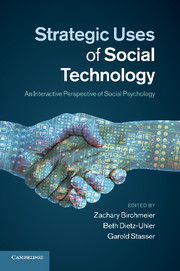Book contents
- Frontmatter
- Contents
- Figures
- Tables
- Notes on the contributors
- Acknowledgments
- 1 Introduction
- 2 A SIDE look at computer-mediated interaction
- 3 Trust, deception, and identity on the internet
- 4 An interactional approach to social influence in computer-mediated communication
- 5 Social interaction in cyberspace
- 6 Dynamics of leader emergence in online groups
- 7 Ostracism in cyberspace
- 8 Opinion-based groups
- 9 A juxtaposition of social influences
- 10 The virtual social world
- Index
- References
4 - An interactional approach to social influence in computer-mediated communication
Published online by Cambridge University Press: 07 October 2011
- Frontmatter
- Contents
- Figures
- Tables
- Notes on the contributors
- Acknowledgments
- 1 Introduction
- 2 A SIDE look at computer-mediated interaction
- 3 Trust, deception, and identity on the internet
- 4 An interactional approach to social influence in computer-mediated communication
- 5 Social interaction in cyberspace
- 6 Dynamics of leader emergence in online groups
- 7 Ostracism in cyberspace
- 8 Opinion-based groups
- 9 A juxtaposition of social influences
- 10 The virtual social world
- Index
- References
Summary
Social interaction leads – online as much as offline – to mutual, more or less equal social influence of the interacting parties on each other. Internet users send out information, summaries of subjective experiences, and opinions using communication tools. Recipients acquire unconsciously new insights or strive to learn or form an opinion about a topic. Research studying the facilitating and hindering factors for such media-based social influence has a long-standing history (for a summary of the early work see Williams, 1977). Nonetheless, the interplay between personality characteristics and media attributes as preconditions of social influence has hardly received any attention yet. Therefore, the current chapter will apply interactionism (Endler and Magnusson, 1976) to online social influence. The combination of personal and situational variables is relevant in the context of new communication media as in any other context, because individuals may respond differently to the specific situational conditions provided by computer-mediated communication (CMC). (For initial evidence see Amichai-Hamburger et al., 2002; Cress, 2005; Guadagno and Cialdini, 2002; Hertel et al., 2008; Sassenberg et al., 2005.) Hence, considering individual differences for the prediction of media effects will allow more precise predictions about the impact of CMC on social influence.
In this chapter, different types of social influence will be introduced and the features of CMC that are relevant for social influence will be discussed. Afterwards, the research on these types of social influence in CMC will be reviewed. This review serves two purposes. First, it will show that almost all existing research in this domain has focused on the impact of situational characteristics that either (a) are inherent in the technology (e.g., few social context cues) or (b) result from the social setting in which CMC takes place (e.g., the impact of group norms on a person's attitudes). Second, it will outline how the moderation of social influence processes by communication media characteristics is best explained by the interactionist approach that includes inter-individual differences (e.g., personality traits). Before this approach is described, the few studies that take into account the moderating impact of inter-individual differences between users on the effects of situational characteristics (i.e., personality traits or cognitive styles) will be summarized. (For a framework model putting forward a similar argument for CMC research in general see Joinson, 2003.)
- Type
- Chapter
- Information
- Strategic Uses of Social TechnologyAn Interactive Perspective of Social Psychology, pp. 63 - 83Publisher: Cambridge University PressPrint publication year: 2011



